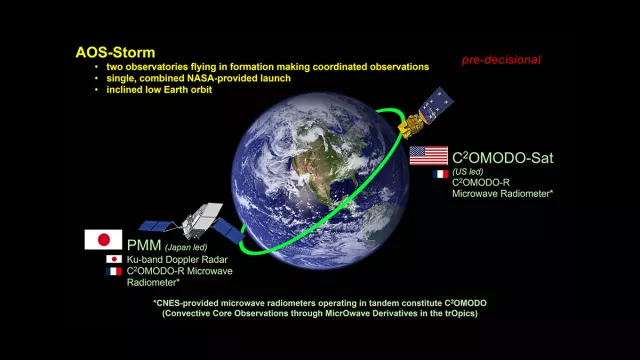The Atmosphere Observing System (AOS) is an international Earth science programme to develop a space observatory comprising several satellites. These satellites will fly in two orbits—polar and inclined—to reveal the relationships between aerosols (fine particulate matter in the atmosphere), clouds, precipitation and storms, with a view to improving weather and climate models.
Within AOS, C²OMODO (Convective Core Observations through MicrOwave Derivatives in the trOpics) is a mission developed by CNES to enhance our understanding of storms and precipitation, and to better characterize deep atmospheric convection. C²OMODO will rely on two microwave radiometers developed by Airbus Defence & Space under CNES supervision and flown on two AOS satellites in the inclined orbit: C²OMODO-Sat (NASA) and PMM (Precipitation Measuring Mission, JAXA).
Key information
| Mission | Understand the development and dynamics of convective systems |
|---|---|
| Domain | Earth observation |
| Launch date | Planned early 2030 |
| Partners | NASA, JAXA |
| Where | Inclined Earth orbit |
| Lifetime | 3 years |
| Status | In development |
Key figures
AOS :
- 8 complementary yet very different instruments
- 6 international partners (NASA, JAXA, CNES, CSA, ASI, DLR)
- 13 contributing French laboratories
C²OMODO :
- 2 new-generation microwave radiometers supplied by CNES
- 3 frequency ranges: 89 GHz, 183 GHz and 325 GHz
- Up to 3-km spatial resolution
Key milestones
- From 2031 : Launches of other satellites in polar orbit to complement the program
- Early 2030: Joint launch of C²OMODO-Sat and PMM carrying French C²OMODO radiometers (inclined orbit)
- July 2024: Transition to Phase B of French contribution to AOS
- May 2021: NASA officially invites CNES to contribute to AOS mission (pre-phase A)
- 2019: CNES Science Survey Seminar and Science Programme Committee recommend France’s participation in AOS
Project in brief
The C²OMODO mission will operate a tandem of microwave radiometers supplied by CNES to drive completely new scientific research into the dynamics of convective systems, a key element to advance our understanding of how the water and energy cycles on Earth respond to a changing climate.
So-called “deep” convective systems play a pivotal role in this process. For example, they drive extensive exchanges of air masses, aerosols and water between the lower and upper layers of the atmosphere. They also have an impact on global circulation of air masses. However, they are still poorly characterized and represented in current weather models or atmospheric circulation models, in particular their vertical velocity.
For the first time, convective systems will be observed by two similar instruments at two-minute intervals and different frequencies, notably to estimate this vertical velocity. Data from this tandem of radiometers will therefore give scientists unique new insights into deep convective systems—which fuel among other things tropical storms—to understand how clouds and storms form and grow. Such enhanced understanding is expected to improve the quality of weather and climate models for better forecasting of extreme events.
CNES’s role
CNES is prime contractor for the C²OMODO mission, France’s contribution to the AOS programme, interfacing with partner space agencies and supporting research laboratories. The agency is notably responsible for supplying two microwave radiometers, one to NASA and another to JAXA, and for developing and delivering the associated processing chains. These C²OMODO Radiometers (C²OMODOR) are being developed by Airbus Defence & Space in Toulouse and data products from the mission will be distributed by AERIS, one of the national data hubs of the Data Terra Earth system research infrastructure.
Contacts
Project Leader
Thierry Amiot
E-mail: thierry.amiot at cnes.fr
Space Segment Manager
Rocio Redondo
E-mail: rocio.redondo at cnes.fr
System Manager
Nathalie Steunou
E-mail: nathalie.steunou at cnes.fr
Atmospheric Physics & Meteorology subject matter expert
Adrien Deschamps
E-mail: adrien.deschamps at cnes.fr


